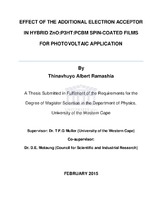Effect of the additional electron acceptor in hybrid ZnO: P3HT:PCBM spin-coated films for photovoltaic application
Abstract
In a quest for low operational and maintenance cost solar cell devices, organic photovoltaics remain a potential source of energy worthy to be explored. In order to generate cost- effective electricity from solar energy, either the efficiency of the solar cells must be improved or alternatively the manufacturing cost must be lowered. The power conversion efficiency (PCE) of organic photovoltaics is influenced by the choice of electron acceptor material, the structure of the polymer, the morphology of the film, the interfaces between the layers and the ratio between the electron acceptor material and the polymer. Nevertheless, efficiency is still limited compared to conventional silicon based PV cells due to low mobility of charge carriers with a short exciton diffusion length in the active layer. Currently, hybrid solar cells have been considered as one of the most promising concepts to address the limited efficiency of organic solar cells. Therefore in this thesis ZnO nanoparticles were synthesized using hydrothermal assisted method. These nanoparticles were incorporated in the poly (3-hexylthiophene) (P3HT):[6,6]-phenyl-C61-butyric acid methyl ester (PCBM), and used as additional acceptors of electrons released from the polymer donor material, with the anticipation to increase the electron mobility, and ultimately the PCE. The thermo-gravimetric analyses revealed improved thermal stability of P3HT upon incorporating ZnO in the polymer matrix. X-ray diffraction analyses revealed that the diffraction peaks shift to higher angles when incorporating the ZnO in the P3HT:PCBM surface and this is consistent with the Raman observation. The photovoltaic properties demonstrated that the addition of ZnO nanoparticles in P3HT:PCBM bulk-heterojunction increases PCE from a baseline of ∼1.0 % in the P3HT:PCBM system to 1.7% in the P3HT:PCBM:ZnO ternary system. The enhanced PCE was due to improved absorption as compared to its counterparts. Upon increasing the addition of ZnO nanoparticles in the P3HT:PCBM matrix, the PCE decreases, due to a large phase separation between the polymer, PCBM and ZnO induced by ZnO agglomerations which resulted in increased surface roughness of the active layer. These findings signify that incorporation of ZnO nanostructures in the P3HT:PCBM polymer matrix facilitates the electron transport in the photoactive layer which results to improved efficiency.

